Silver Spring Lakes is one of my favourite hidden gems of the Elk Valley, and the hike alongside these three stunning lakes is one of my favourite things to do when spending time in Fernie. Each lake is a slightly different colour, but all three are crystal clear, writhing with fish, and the first and third, the most beautiful, are impossibly deep. Walking alongside these three beautiful blue-green lakes bordered by dramatic cliffs, it’s easy to imagine you’re in some high remote alpine paradise, but in fact Silver Spring Lakes are conveniently accessed by only a short walk from the road.
Popular among locals as a swimming hole and for its excellent cliff jumping, the first of the Silver Spring Lakes is a busy spot on hot summer day. Unlike many beautiful mountain lakes at higher elevations, Silver Spring Lakes are all perfect temperatures for swimming. During the first initially steep section of trail up to the first lake, don’t be surprised to see locals lugging SUPs or kayaks up the trail.
After following the initial short but steep uphill trail to the spectacular but popular first lake, the Silver Spring lakes trail continues fairly flatly through the canyon towards the much more quiet second and third lakes. This trail is one the absolute best hikes near Fernie for just how rewarding it is for such little work. There are no dramatic summit views to huff and puff up to, just a serene and peaceful walk through one of the most beautiful areas in the region. Oh, and bring your swimming trunks.
Continue reading this blog post for everything you need to know to experience the Silver Spring Lakes hike near Fernie for yourself, including distance, elevation gain, how to get there, the best time to visit, and lots of photos of my experience.
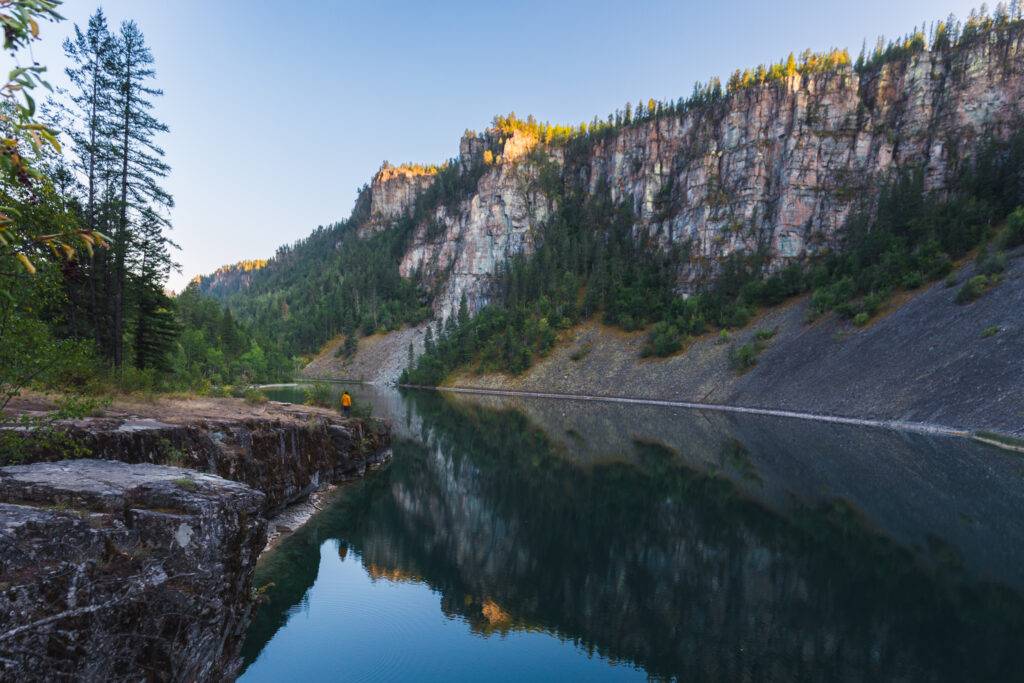
When hiking it’s important to avoid harmful practices such as disturbing plants or rock-stacking, or removing any natural object from flowers to rocks, as it’s important to leave the environment as natural as possible for the animals and for fellow hikers to enjoy in perpetuity. As many flowers as there are, there are few enough that if we all took one, then there wouldn’t be any left. Take only photos, leave only footprints.
If you haven’t heard of Leave No Trace principles, they’re also really essential to read up on before heading anywhere into the outdoors in general. Following these important principles basically means doing your best to leave beautiful places like Silver Spring Lakes as good (if not better) than you found them, both for their preservation and for the enjoyment of other visitors.
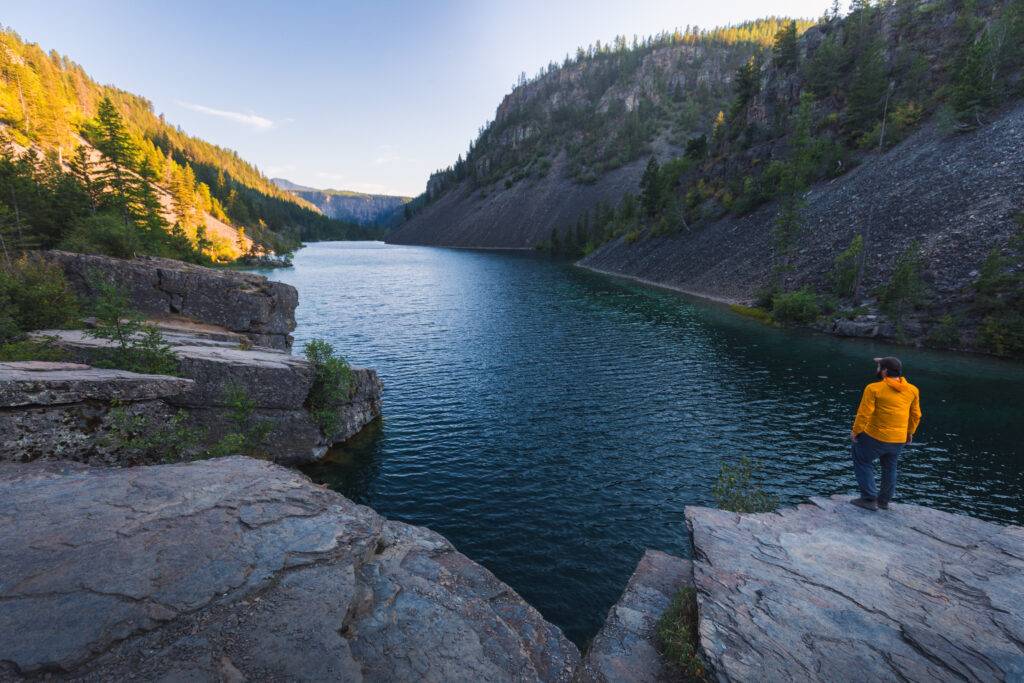
Silver Spring Lakes Round Trip Details
Distance: 7 KM / 4.3 MI
Elevation Gain: 200 M / 656 FT
Hiking Time: 2 HRS
Hiking & Safety Tips
- Prepare for the possibility of wildlife encounters. Bear spray is a must whenever travelling in bear country, as well as learning how to use it. Though your chance of an aggressive bear encounter is low, it is always better to be prepared with bear spray. Bear bells are proven to be an ineffective bear deterrent, and are actively discouraged by Parks Canada. The best way to let bears know you’re around is simply to use your voice. Make sure to keep a respectful distance from wildlife and never feed the animals. It may seem kind but it doesn’t just kill wildlife and put people in danger, it’s also in many cases illegal.
- Research current trail conditions and make sure you are well-informed about the route before you leave, and assess if it is within your capability. Be aware of what time it gets dark and check the weather forecast. Make sure to tell someone where you’re going and when you expect to return. Every year as more and more people try hiking for the first time, the number of rescues goes up. Being prepared is the best defense.
- Pack everything you need for a successful hike, including enough water and energy-rich snacks. Remember to pack out everything you pack in though – don’t expect to find a convenient garbage can halfway up the trail. Bring appropriate layers (remember you’ll warm up once you start hiking) and sun protection. Hiking poles may be helpful but are not required. In addition to not leaving any garbage on the trail yourself, I highly recommend bringing a garbage bag and collecting any trash that you do see on the trail. You’re guaranteed to make the hike along Silver Spring Lakes a more enjoyable experience for the next person.
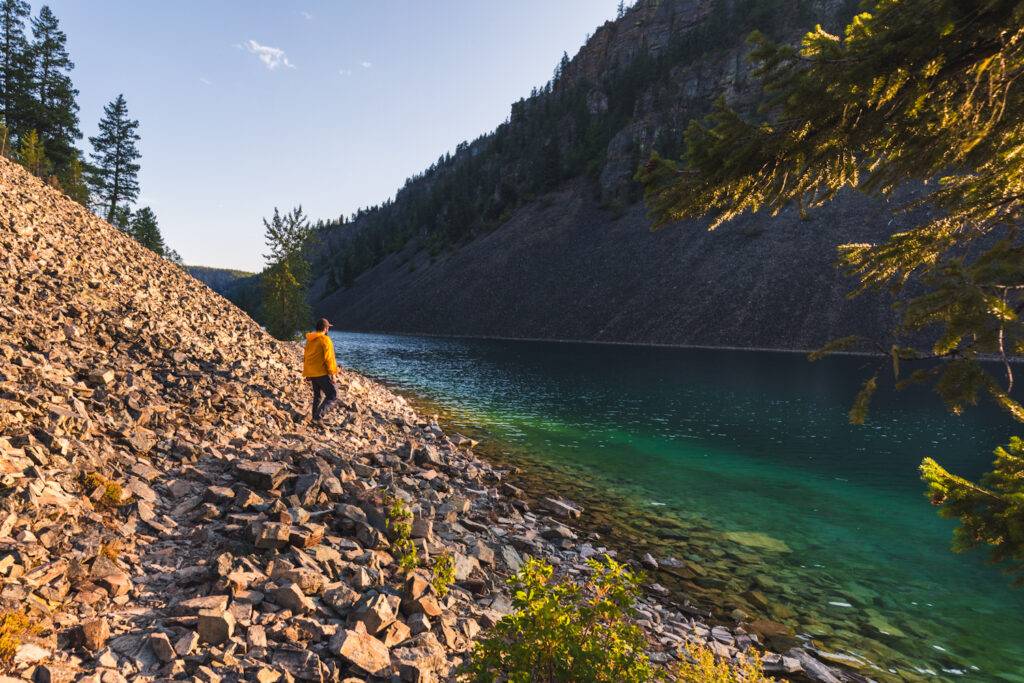
How to Get to Silver Spring Lakes Trailhead
The Silver Spring Lakes trailhead is located just outside of Elko, about half an hour from Fernie, or just under an hour from Cranbrook. If driving from Fernie, turn left onto Bate Ave just after crossing the bridge in Elko. From Cranbrook, turn right onto Bate Ave just before the bridge and after climbing the hill into town. From Elko the trailhead is five minutes away. The road goes up three blocks before turning right, then turns left after another two blocks. After the road leaves the residential part of town behind, look for the active logging road turning sharply to the right. Drive carefully, yielding to logging trucks. The road soon crosses a bridge and passes by the trailhead for the Silver Spring Rim trail. Continue for 2.7 km until you reach an area where the road widens with room for many cars. Park here.
Click here to open the exact trailhead location in Google Maps.
Hiking to Silver Spring Lakes

The trailhead for Silver Springs Lakes is a bit easy to miss at the beginning of the parking area. Pretty immediately it starts uphill heading towards the lakes.
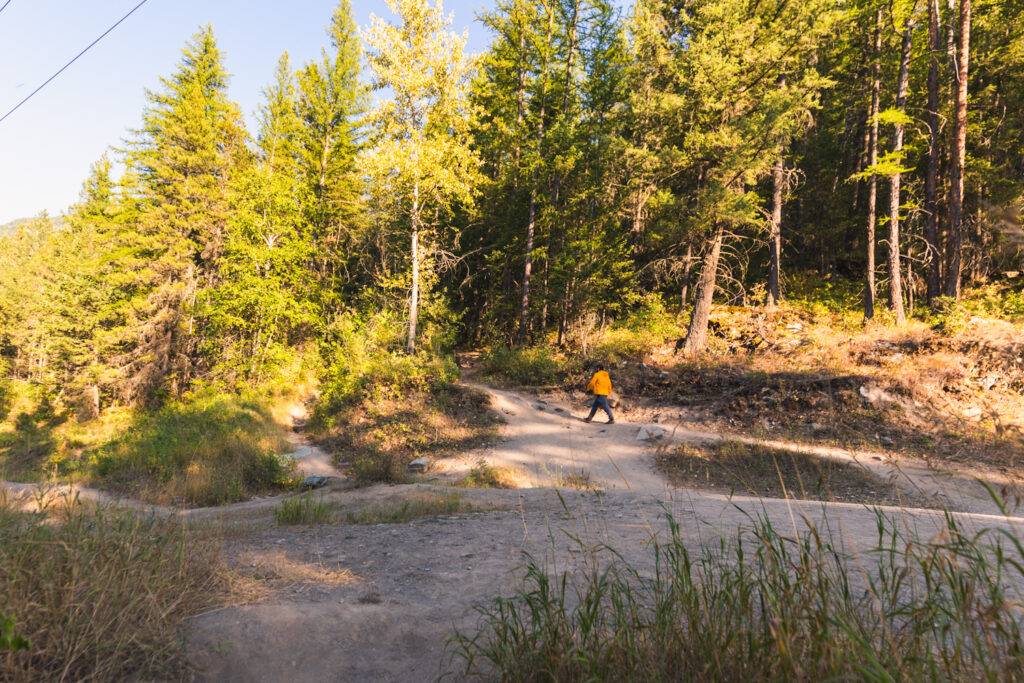
The trail passes underneath power lines and their access road and resumes ascending on the other side.
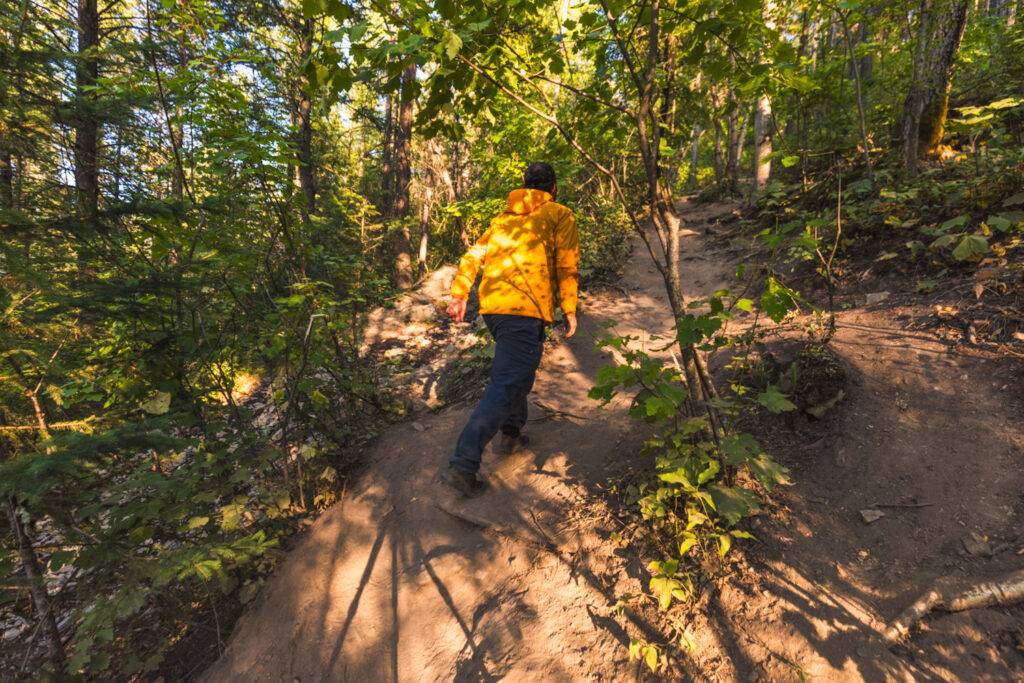
Heading up the trail parallels an old road with a stream running down it. Despite being only about fifteen minutes to the first lake, this section is still bound to get your blood pumping.
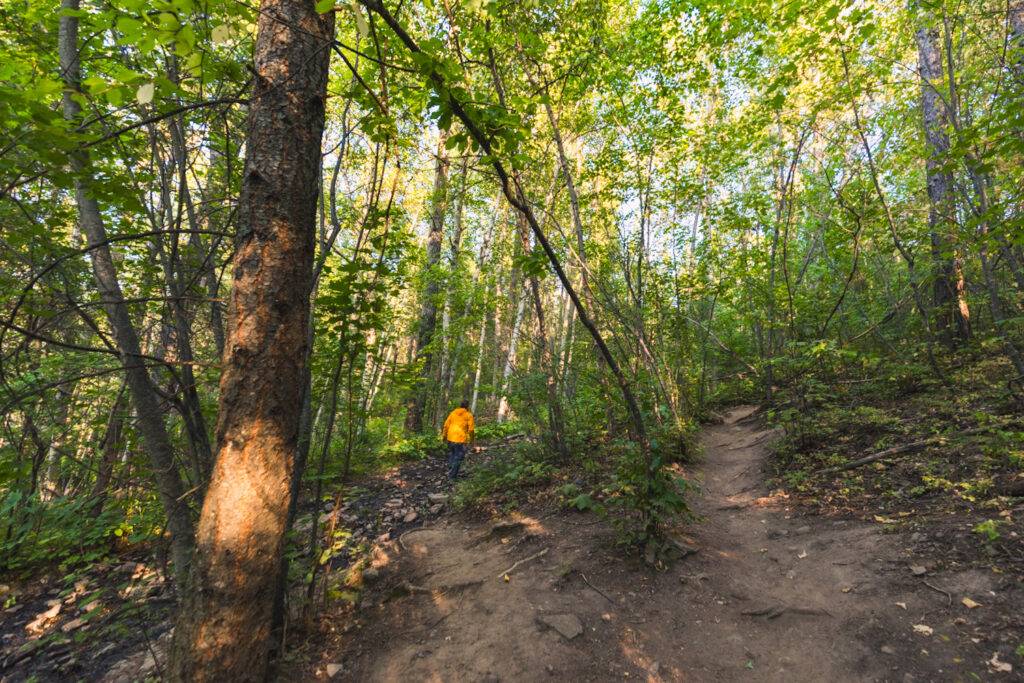
Make sure to cross left onto the old road / stream before the smaller path turns away to the right. Some people choose to cross over sooner rather than later but it doesn’t really matter.

The first of the Silver Spring Lakes visible up ahead. Head left here to skirt around to the left side of the lake.

There are a whole bunch of braided trails on the left side of the lake near the cliff jumping spot. I suggest keeping close to the lake as you continue up alongside it. Eventually the various trails will unite into one as you make your way along the lakeshore.

A recently built pit toilet near the cliff jumping spot. I can’t imagine how much used toilet paper was being left in the bushes near this popular spot so the infrastructure is a welcome sight.

The trail makes its way along the bottom of talus slopes very near the lakeshore. It was challenging to photograph the beautiful blue-green colour of the lake water so late in the day, but this photo did a decent job. Look closely in the water here – I saw hundreds and hundreds of tiny little fish.

Lovely views of unnamed mountains behind me.

After passing the first lake the trails enters the woods. There are few views of the second lake as this area is heavily wooded as well.

The best views looking down the second lake. This lake is the least popular as it is not as vibrantly coloured as the others. After leaving the second lake the trail once again heads through the woods towards the third lake further on down the canyon.

Larger talus just before the third lake. The trail can be a little hard to follow here, but just keep in a straight line until you see it heading back into the trees at right.
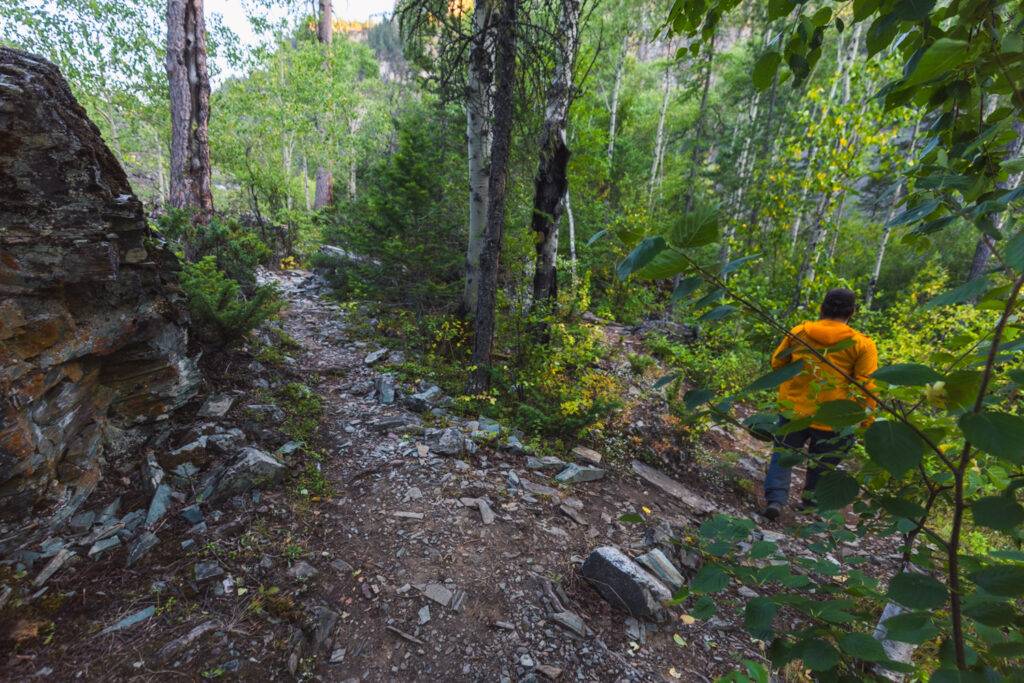
A junction just before the third lake. Head right to the viewpoint at the toe of the lake. The route on the left continues alongside the lake but becomes overgrown eventually.
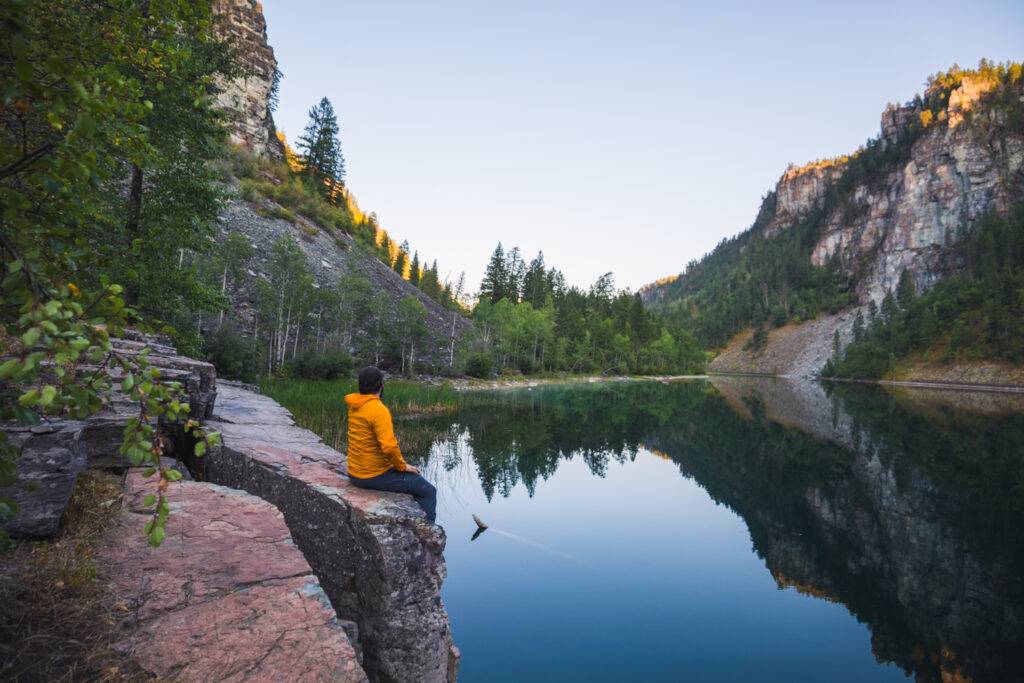
Beautiful views of the third of the Silver Spring Lakes. This lake was full of large fish that would jump out of the otherwise calm water every thirty seconds.
Recommended Hiking Gear



Water is a must whenever I’m hiking, especially if the sun is going to be out. My favourite water filter I’ve used is the Katadyn BeFree 0.6L, which unlike other water filters I’ve used packs up really small and lightweight. For hikes where I know there won’t be any readily available water sources along the way, I make sure to bring my own. The Hydrapak Stow 1L bottle is my go-to, for the same reason that it’s made of a soft plastic that folds up and doesn’t take up any more extra space than necessary in my pack. Finally, Aquatabs are another great option for purifying water, with one tablet being suitable for one litre of water. I previously used the Grayl water filter while travelling internationally, and though I found its hard body more convenient for day to day use and easier to drink from, it has a little too much bulk for my fast-and-light style of hiking.



The secret to all my photos of gorgeous sunset and sunrise mountaintop views? A lot of hiking in the dark. And let me speak from personal experience when I say that the last thing that you want to happen when hiking is to be caught in the dark without a headlamp. I used the Black Diamond Spot 400 for years and it worked great – until I lost it on top of a mountain somewhere. The only downside to it was having to worry about the batteries dying, though there’s also a slightly more expensive version that has a rechargeable battery. Nowadays I’m using the Petzl Actik Core, which is a bit pricier than the more budget-friendly Black Diamond, but is also brighter, more comfortable (in my opinion), and has a hybrid power system that is rechargeable but can also take AAA batteries if needed.
You won’t see me using trekking poles on shorter hikes often – but on long hikes and backpacking trips, as well as certain scrambles, they are an absolute lifesaver. I’ve invested in a high quality ultra-lightweight pair of MSR DynaLock Ascent carbon poles which, while pricey, I don’t regret one bit. If you’re not entirely sure how much use you’re going to get out of a pair of trekking poles, the best budget-friendly option would be the Trekology Trek Z 2.0. Amazon does sell a lot of cheaper Made in China-style trekking poles for cheaper, but these usually are much much heavier and not worth buying.
All the best and most long-lasting cables and power banks I’ve ever owned have been Anker. I once had a phone cable from them that lasted me over three years of daily use! That’s why I keep an Anker PowerCore Essential 20K power bank on me. Like many people I use my phone for a lot of stuff when hiking (checking in with family, using online maps, taking photos, flying my drone) so I like to be prepared for that low battery warning by having a backup power source on me just in case.



The only socks I ever buy for myself are from Darn Tough, and I almost always make sure to wear them when hiking. After years of having no problems only wearing these comfortable and rugged socks for hikes, I accidentally wore a pair of no-name socks on a hike last year and ended up with blisters on both feet. Safe to say I’m back to sticking with the Darn Tough. And the best part? They have a lifetime guarantee, meaning that if they ever wear out you can send them back for a brand new pair. For hiking footwear I go between a pair of lightweight approach shoes for quick and dirty mountain ascents or anything involving scrambling and more heavy-duty boots for longer treks. I’ve worn a couple different versions of the lightweight but super durable Arc’teryx Konseal FL 2 approach shoes for a few years now and am very impressed with the durability. I also really like the thick toecap that keeps me protected every time I stumble into a root or large rock. For longer, tougher, or muddier treks I rely on my LOWA Camino EVO GTX, which I find insanely comfortable and made of very high quality.



I wear my Ar’teryx Gamma Lightweight Pants on every single hike I go on, and on many days when I’m not hiking. After several years of abuse they are still holding together extraordinarily well, with only a few small holes from where I’ve fallen down and some slight stains from being repeatedly coated with mud. They’re lightweight, breathable, and super comfortable. For lightweight and breathable hiking tops I’m a big fan of both the Patagonia Capilene Shirt and the MEC Core Shirt. My Arc’teryx Squamish Hoody shows up in a lot of my photos. It’s super lightweight and packable, and does a great job of cutting the wind while also being pretty breathable. I also have an Arc’teryx Atom Hoody and Arc’teryx Beta LT that I pull out for cooler or wetter conditions.
I hope you enjoyed this guide to hiking to Silver Spring Lakes near Fernie! Feel free to leave any questions in the comment section below or to contact me directly via social media.

As a resident of Elko, BC, I rarely go to Silversprings, along with the rest of the community, we deal with a huge amount of disrespect each year. in the fall the residents do a big clean up, you should mention of you swim to the bottom of the lake it has a layer of beer cans at the bottom, people treat the community as a race course, and it’s unsafe for children to play, these articles are continuing to bring more people and you are contributing to ruining a once beautiful community. In the evening all i can hear are people yelling at cars to slowdown, i myself have almost been hit by vehicles many times with my dog. Your article is heartbreaking to anyone who lives in Elko, inviting people to destroy our likelihood.